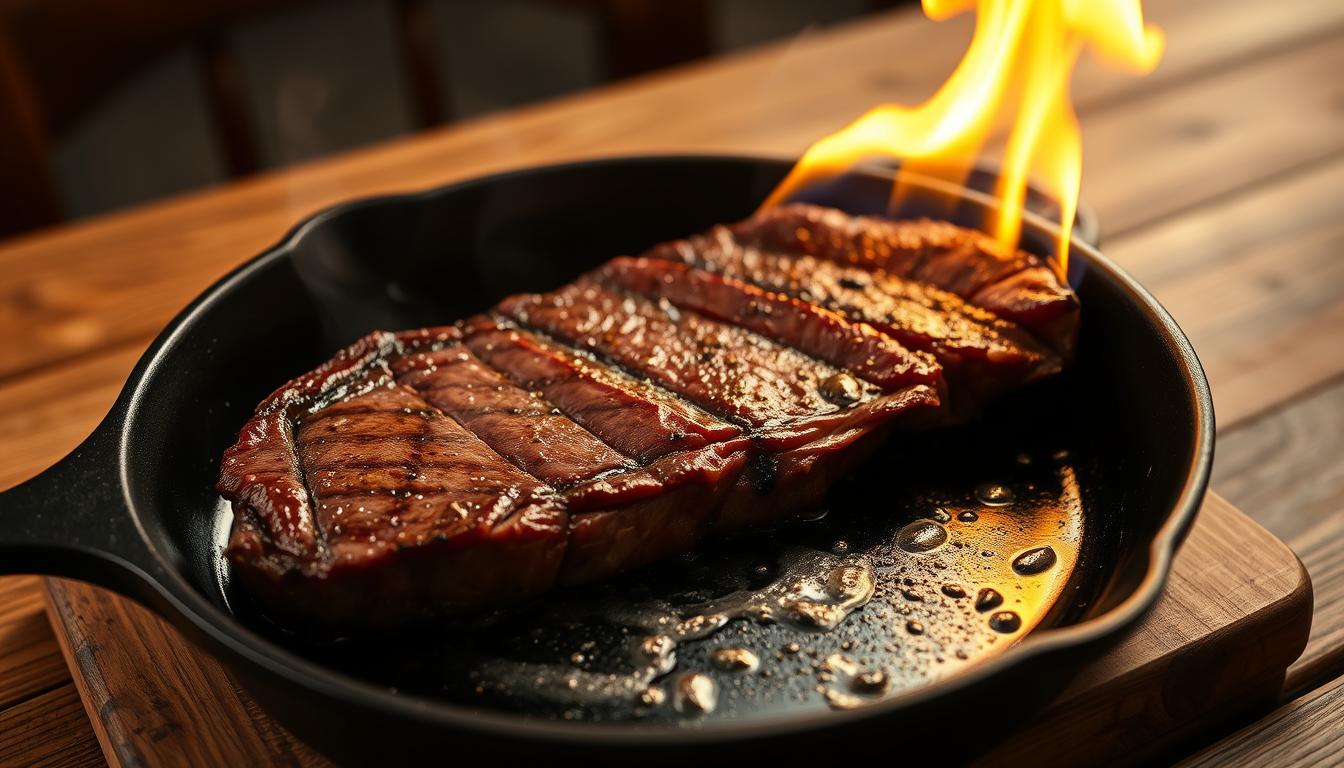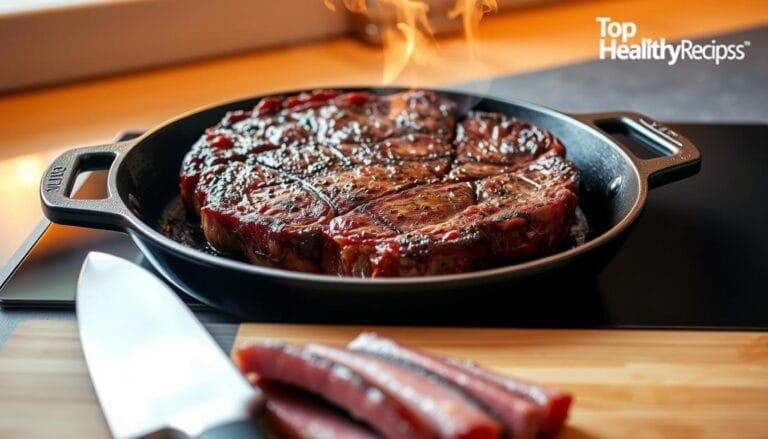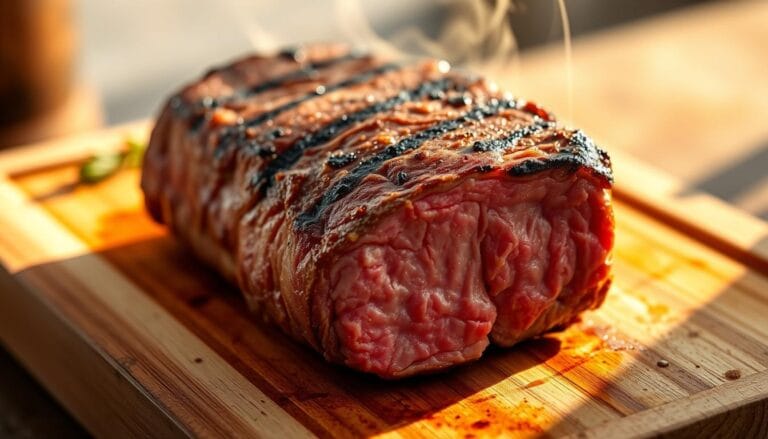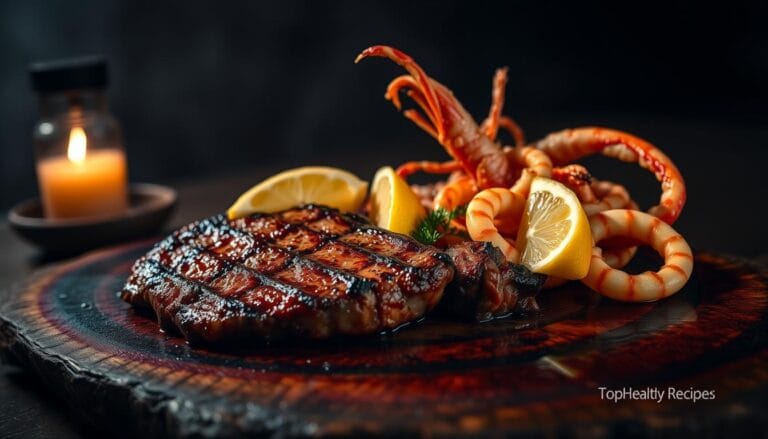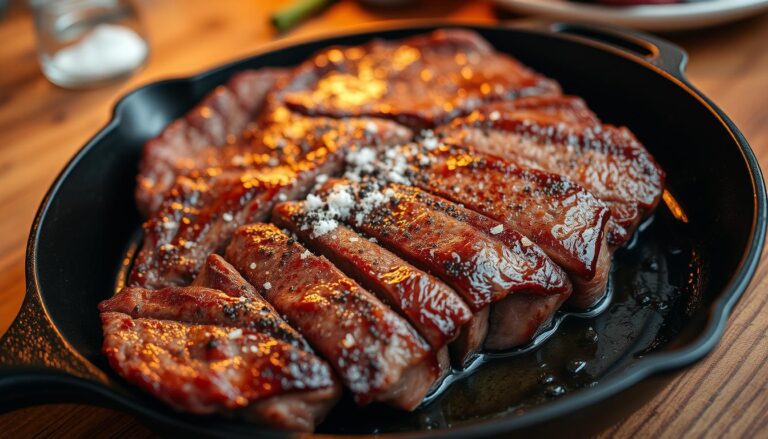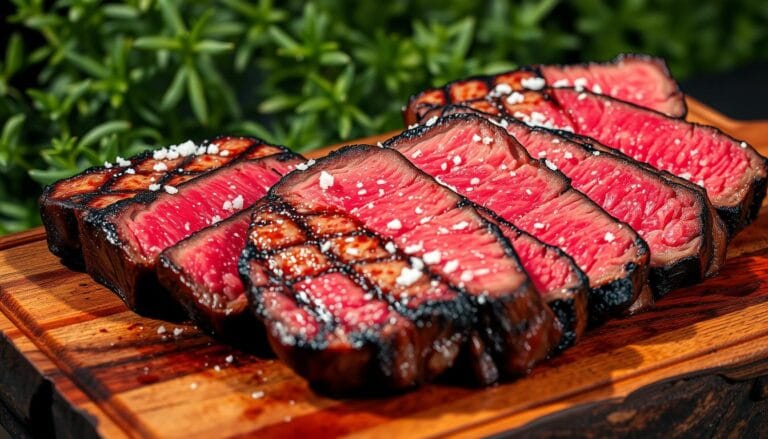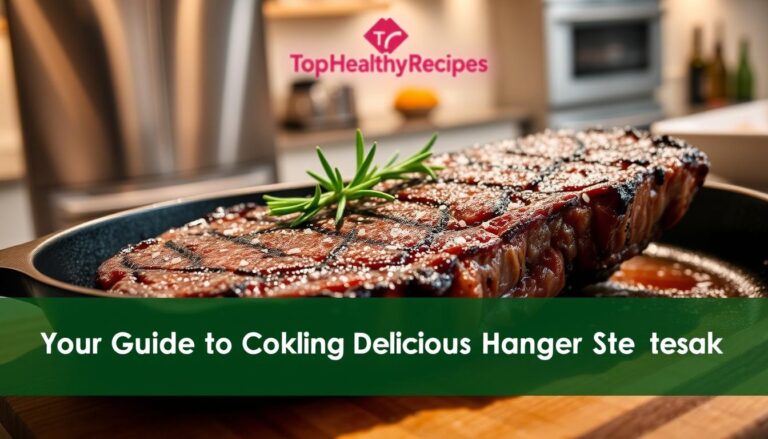What Are Denver Steaks? Discover This Juicy and Underrated Cut
Table of Contents
What Are Denver Steaks? Discover This Juicy and Underrated Cut
Ready to take your grilling to the next level? The Denver steak is your answer. It’s tender, flavorful, and perfect for any meal.
More people are finding out why Denver steak is a game-changer. Its unique taste and soft texture make it a hit. It’s quickly becoming a top choice for steak lovers.
Key Takeaways
- Discover the unique characteristics of Denver steak
- Learn about the flavor profile and texture
- Explore cooking techniques and pairing suggestions
- Understand why Denver steak is gaining popularity
- Get tips on incorporating Denver steak into your culinary repertoire
What is Denver Steak?
Denver steak is a special cut of beef known for its tenderness and flavor. It’s a great choice for steak lovers looking to try something new. Knowing what makes Denver steak unique can make your dining experiences even better.
Definition and Origin
The Denver steak comes from the chuck or shoulder area of the beef. It’s from the serratus ventralis muscle under the blade bone. This cut was found during the Beef Checkoff Program’s muscle profiling research.
This research aimed to find undervalued cuts of meat. It led to the discovery of the Denver steak. Despite coming from a less prized section, it’s incredibly tender.
The Denver steak’s origin is linked to the North American meat industry’s efforts. They wanted to promote lesser-known cuts. By naming cuts like the Denver steak, they made high-quality beef more affordable for everyone.
Unique Characteristics
The Denver steak is known for its exceptional tenderness and rich flavor. It comes from an area that gets little exercise, making it surprisingly tender. Its marbling adds to its flavor and tenderness.
- Rich beefy taste
- Exceptional tenderness
- Good marbling for flavor
The Denver steak’s balance of marbling, tenderness, and flavor is appealing. It’s a great choice for those wanting to try something new without spending a lot. Understanding its unique qualities can help you see its value.
How Denver Steak is Cut
To truly appreciate Denver steak, it’s essential to understand the intricacies involved in cutting it. The process begins with the chuck roll, a section of the beef from which skilled butchers carefully extract the Denver steak.
Cutting Process Explained
The cutting process involves several precise steps. First, the chuck roll is separated from the chuck under blade. Then, the connective tissue and fat are carefully removed to reveal the well-marbled muscle that becomes the Denver steak.
This meticulous process is a key reason why Denver steak is not as commonly available as other cuts. It may require a special request to your butcher. The complexity and the skill involved in cutting Denver steak contribute to its pricing.
Key Steps in Cutting Denver Steak:
- Separation from the chuck under blade
- Removal of connective tissue and fat
- Revelation of the well-marbled muscle
Ideal Thickness for Cooking
When purchasing Denver steak, the thickness is a key factor. Look for steaks cut to a thickness of 1 to 1.5 inches. This thickness is optimal for most cooking methods, allowing for a proper sear on the outside while maintaining a juicy interior.
| Thickness | Cooking Method | Result |
|---|---|---|
| 1 inch | Grilling | Quick sear, juicy interior |
| 1.5 inches | Pan-searing | Even cooking, tender texture |
As
“The quality of the steak is directly related to the skill of the butcher,”
a principle that highlights the importance of understanding the cutting process for a cut like Denver steak.
By appreciating the care and precision that goes into cutting Denver steak, you can better enjoy the rich flavors and tender texture this cut has to offer.
Cooking Methods for Denver Steak
The Denver steak is perfect for many cooking methods, like grilling and sous vide. Learning these techniques will help you enjoy this amazing beef cut to the fullest.
Grilling Denver Steak
Grilling Denver steak adds a smoky taste and tender texture. First, heat your grill to high. Cook for 4-5 minutes on each side for a perfect medium-rare. Always let the steak rest to keep the juices inside.
Pan-Searing Techniques
Pan-searing is great for Denver steak, using a cast-iron skillet. To get a perfect crust, choose the right oil and heat it well. Then, baste the steak with butter and herbs for extra flavor.
Using Sous Vide for Precision
Sous vide cooking is perfect for Denver steak because it controls temperature precisely. For medium-rare, set the temperature to 129-134°F. After, sear it quickly in a hot pan for a nice crust.
| Cooking Method | Key Benefits | Tips for Denver Steak |
|---|---|---|
| Grilling | Smoky flavor, tender texture | Cook for 4-5 minutes per side for medium-rare |
| Pan-Searing | Restaurant-quality crust, rich flavor | Use cast-iron skillet, baste with butter and aromatics |
| Sous Vide | Precision temperature control, consistent results | Cook at 129-134°F for medium-rare, then sear |
Each cooking method can highlight the Denver steak’s best qualities, based on your taste and tools. Try different ways to find your favorite way to enjoy this exceptional beef.
Flavor Profile of Denver Steak
The Denver steak is known for its deep, intense beef flavor. It comes from the chuck section, where the muscles work hard. This makes the meat taste more robust.
The rich and beefy taste of Denver steak comes from its origin and the natural processes in the meat. The muscles in the chuck section add to its bold flavor compared to other cuts.
Rich and Beefy Taste
The Denver steak’s flavor is often called beefy and rich. This is because of the muscles in the chuck section. These muscles make the steak taste more intense.
Marbling and Tenderness
The steak’s marbling also plays a big role in its flavor. The fat in the meat melts when cooked. This makes the steak moist and full of flavor.
| Characteristics | Denver Steak | Ribeye |
|---|---|---|
| Marbling | Abundant | Very Abundant |
| Tenderness | High | High |
| Flavor Profile | Rich, Beefy | Rich, Beefy |
Studies show Denver steaks are the fourth most tender cut of beef. Despite coming from the chuck, they offer great value compared to pricier cuts.
Ideal Seasonings for Denver Steak
Make your Denver steak taste amazing with the right seasonings. These can highlight the steak’s natural flavors without being too strong.
Seasoning Denver steaks is best kept simple. Use kosher salt and freshly ground black pepper about 45 minutes before cooking. This lets the flavors soak in and brings out the steak’s taste. For more flavor, try adding garlic powder, onion powder, or herbs like rosemary or thyme.
Classic Seasoning Blends
Start with classic seasoning blends for your Denver steak. Here are some favorites:
- A mix of paprika, garlic powder, and onion powder for a smoky taste
- A blend of dried thyme, rosemary, and parsley for a herby flavor
- A simple mix of kosher salt, black pepper, and a bit of cayenne pepper for more depth
Marinades for Extra Flavor
Marinades can add a lot of flavor to your Denver steak. It’s key to not overpower the meat’s natural taste. Use acidic ingredients like vinegar or citrus carefully, as they can make the steak too tender. Oil-based marinades with herbs and spices are better for keeping the meat’s texture.
Here are some marinade ideas:
- A coffee-based marinade that boosts the meat’s richness
- A classic red wine marinade that complements the beef’s strong taste
- An Asian-inspired soy-ginger blend that adds a unique and savory flavor
Timing is important when using marinades. For Denver steaks, 2 to 4 hours is enough to soak up flavors without changing the texture. Try different marinades and seasonings to find what you like best.
Pairing Sides with Denver Steak
Choosing the right sides can make your Denver steak meal even better. It’s all about finding flavors and textures that match the steak’s rich taste.
Best Vegetables to Serve
Grilled or roasted veggies are perfect with Denver steak. Asparagus offers a tender bite and a hint of bitterness. Brussels sprouts roasted bring out a deep, earthy flavor. Bell peppers add crunch and sweetness, no matter their color.
Seasonal veggies offer a variety all year. In summer, try a mix of zucchini, eggplant, and cherry tomatoes for a colorful side. In winter, roasted carrots and parsnips make a hearty match for the steak.
| Vegetable | Preparation Method | Flavor Profile |
|---|---|---|
| Asparagus | Grilled or Roasted | Tender, slightly bitter |
| Brussels Sprouts | Roasted | Earthy, caramelized |
| Bell Peppers | Grilled | Crunchy, sweet |
Complementary Starches
The right starch can enhance the Denver steak. Twice-baked potatoes offer a creamy inside that matches the steak. Garlic mashed potatoes add a rich, savory taste.
For something different, try crispy roasted fingerling potatoes or creamy polenta. Wild rice pilaf also works well, with its nutty flavor and satisfying texture.
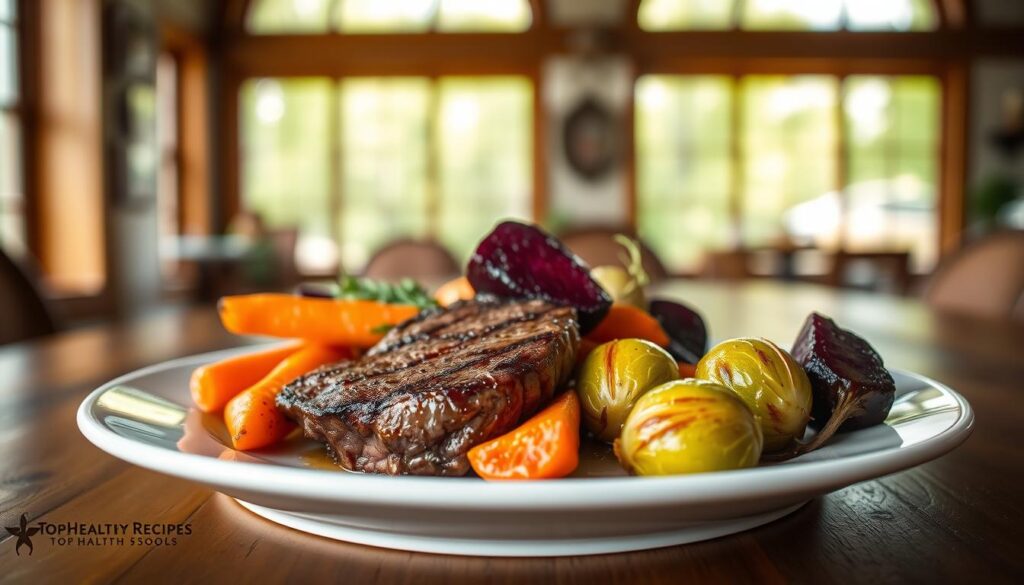
Frequently Asked Questions about Denver Steak
Thinking about trying Denver Steak? You might wonder about its characteristics and how to cook it. This cut from the chuck section has gained fame for its unique taste and texture.
Tenderness of Denver Steak
Many ask about Denver Steak’s tenderness. Despite coming from the chuck section, known for tougher cuts, Denver Steak is surprisingly tender. It ranks fourth in tenderness, thanks to its location in a less-used muscle. This makes it a great choice for tender steak lovers without the high cost of premium cuts.
Comparison to Other Cuts
It’s natural to compare Denver Steak to other steak cuts. Here’s how it compares:
- vs. Ribeye: Denver Steak is more affordable but has a similar flavor. It’s a good choice for those who want ribeye taste without the high price.
- vs. Strip Steak: Denver Steak is slightly less tender but has similar marbling. This adds to its rich flavor.
- vs. Flat Iron: Both are tender, but Denver Steak has a unique grain structure. This offers a different dining experience.
- vs. Flank Steak: Denver Steak needs different cooking techniques due to its thickness and marbling. This makes it versatile for various cooking methods.
Cooking Time and Temperature Guidelines
Getting the perfect doneness is key when cooking Denver Steak. Here are some guidelines:
| Doneness | Internal Temperature | Cooking Time (approx.) |
|---|---|---|
| Rare | 125°F | 4-5 minutes per side |
| Medium-Rare | 135°F | 5-6 minutes per side |
| Medium | 145°F | 6-7 minutes per side |
Note that cooking times may vary based on the steak’s thickness and your preferred cooking method. For precise results, consider using a meat thermometer to check internal temperatures.
Nutrition Facts of Denver Steak
Knowing the nutritional value of Denver steak helps you choose better meals. It’s known for its rich flavor and tender texture. Plus, it’s packed with nutrients, making it a great choice for a balanced diet.
Caloric Content
A 6-ounce serving of Denver steak has about 330-380 calories. The exact calories depend on the beef’s trim and grade. Compared to other cuts, Denver steak has a balanced calorie count. This makes it a good option for those watching their calories.
| Serving Size | Calories | Protein | Fat |
|---|---|---|---|
| 6 oz | 330-380 | 40-45g | 15-20g |
| 8 oz | 440-507 | 53-60g | 20-27g |
Key Nutrients
Denver steak is a top-notch protein source, with 40-45 grams per 6-ounce serving. It’s also full of B vitamins like B12, niacin, and B6. Plus, it has minerals like zinc, iron, and phosphorus. These nutrients help with energy, muscle repair, and immune function.
Nutritional Highlights:
- High-quality protein for muscle building and repair
- Rich in B vitamins for energy production and neurological health
- Good source of minerals like zinc and iron for immune function and oxygen transport
The fat in Denver steak is a mix of saturated and unsaturated fats. The marbling adds to its tenderness and flavor. Knowing this helps you make better choices when adding Denver steak to your meals.
Where to Buy Denver Steak
Finding a great Denver steak starts with knowing where to look. Whether you’re a steak expert or new to Denver steaks, it’s key to find quality sources.
Local Butcher Shops
Local butcher shops are top choices for Denver steaks. They offer more flexibility than big supermarkets. When you visit, get to know the butcher and ask about their cutting methods.
You might need to ask for a “chuck under blade steak” or “underblade steak.” These are other names for Denver steak.
- Ask about the meat’s origin
- Find out about their cutting practices
- Request specific cuts or thicknesses
Online Meat Suppliers
Online meat suppliers are great for those who shop from home or can’t find Denver steaks nearby. Sites like Snake River Farms, Porter Road, and Crowd Cow offer quality Denver steaks. When shopping online, think about shipping costs, packaging, and product reviews.
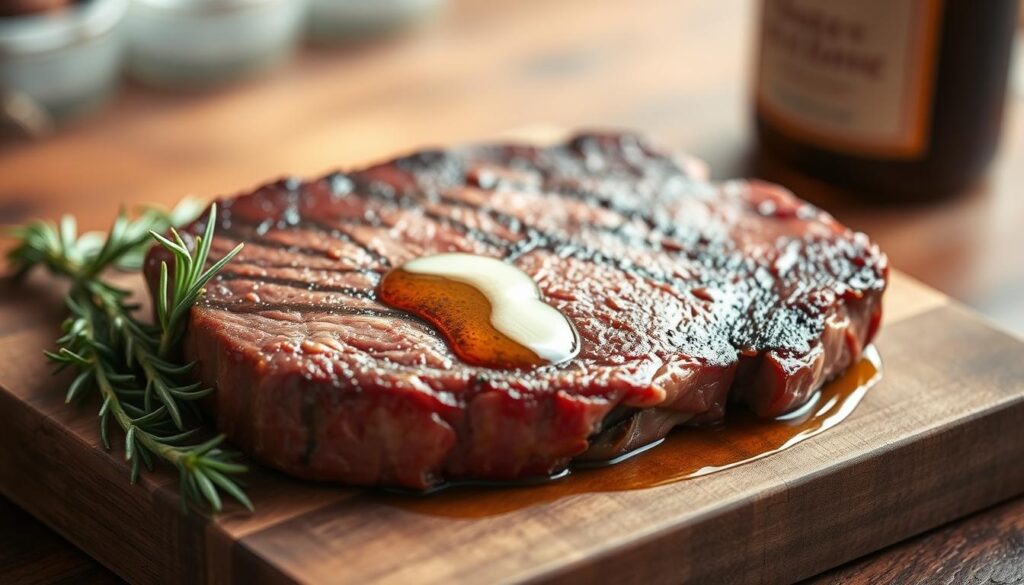
Buying online can also mean buying in bulk and freezing for later. This can save money and let you enjoy Denver steaks all year.
- Check customer reviews and ratings
- Look for detailed product descriptions
- Consider shipping and handling
Looking at both local butcher shops and online suppliers can help you find the perfect Denver steak. Whether it’s for a special event or a simple dinner, the right cut makes all the difference.
Tips for Buying Quality Denver Steak
When you’re looking for Denver steaks, there are a few important things to keep in mind. Knowing these can make your meal better and more enjoyable.
To buy a good Denver steak, you need to know what to look for. The quality of a Denver steak depends on its marbling and the USDA grade.
Look for Marbling
Marbling is key to a Denver steak’s quality and taste. It’s the fat that’s mixed into the meat. Fine, evenly distributed white flecks mean good marbling. This makes the steak taste better, feel softer, and stay juicier.
- Choose steaks with fine marbling all over, not big chunks of fat.
- Steaks with little marbling might taste less good and be less tender.
As the steak cooks, the marbling melts. This makes the meat stay moist and full of flavor.
Choosing the Right Grade
The USDA grading system is also important when buying Denver steaks. The grades are Prime, Choice, and Select.
- Prime: Lots of marbling, super tender, and rich in flavor. Prime Denver steaks are top-notch but pricier and harder to find.
- Choice: Some marbling, very tender, and flavorful. Choice-grade Denver steaks are a great value, balancing quality and cost.
- Select: Leaner cuts with less marbling. They can be tender but need careful cooking to get the best taste.
Even Choice-grade Denver steaks can offer a great dining experience. Knowing these grades helps you choose based on your budget and taste.
Denver Steak in Popular Culture
The Denver steak’s rise in fame is an interesting tale of changing tastes. Over the last ten years, it has become well-known in the food world. This is thanks to its appearance in famous cookbooks and on restaurant menus.
Its journey to fame started with mentions in meat-focused books. Cookbook writers have helped make this cut famous by showing its value and flexibility. For example, “The River Cottage Meat Book” by Hugh Fearnley-Whittingstall was an early supporter. Later, chefs like Pat LaFrieda and Meathead Goldwyn included it in their recipes. These books have not only highlighted the Denver steak’s taste but also given home cooks new ways to cook it.
Mention in Cookbooks
Cookbooks have been key in making the Denver steak well-known. By including it in their recipes, authors have taught home cooks about its special qualities. Some notable examples include:
- The River Cottage Meat Book by Hugh Fearnley-Whittingstall, which introduced the Denver steak to a wider audience.
- Meathead: The Science of Great Barbecue and Grilling by Meathead Goldwyn, which provides a scientific approach to cooking Denver steaks.
- Pat LaFrieda’s Meat Guide by Pat LaFrieda, which offers expert advice on selecting and preparing Denver steaks.
Featured in Restaurants
Many chefs across the country have also helped make the Denver steak famous. They have added it to their menus, from fancy steakhouses to farm-to-table places. Some notable examples include:
| Restaurant | Location | Signature Preparation Method |
|---|---|---|
| The Purple Pig | Chicago | Grilled Denver steak with chimichurri sauce |
| Franklin Barbecue | Austin | Pan-seared Denver steak with roasted vegetables |
| Langbaan | Portland | Dry-aged Denver steak with fermented vegetables |
These restaurants, among others, have shown the Denver steak’s versatility and taste. They have inspired home cooks to try new things with this cut. By looking at how chefs and cookbook authors use the Denver steak, we can learn more about its growing popularity and find new ways to cook it at home.
Denver Steak Recipes to Try
Discover the versatility of Denver steaks with these delicious and easy-to-follow recipes. They will elevate your dining experience.
Grilled Denver Steak with Chimichurri
Grilling Denver steak to perfection is a great way to enjoy its rich flavor. Start by seasoning the steak with salt, pepper, and your choice of herbs. Grill the steak over medium-high heat for 4-5 minutes per side, or until it reaches your desired level of doneness. Let it rest before slicing.
The chimichurri sauce is a classic Argentinean condiment that pairs perfectly with grilled meats. To make it, combine 1 cup of fresh parsley, 1 cup of fresh cilantro, 4 cloves of garlic, 1/2 cup of red wine vinegar, and 1/4 cup of olive oil in a food processor. Process until the mixture is well combined but not too smooth. Season with salt to taste.
Denver Steak Tacos
Transform your Denver steak into a flavorful taco filling by slicing it thinly against the grain after cooking. For a delicious marinade, mix 1/4 cup of lime juice, 2 cloves of minced garlic, 1 teaspoon of cumin, and 1/2 teaspoon of chili powder. Marinate the steak for at least 30 minutes before cooking it to your desired doneness.
Serve the sliced steak in warm corn tortillas, topped with quick-pickled onions, crumbly cotija cheese, and diced avocado. This recipe not only stretches your Denver steak investment but also brings a vibrant and balanced meal to your table.
Storing and Freezing Denver Steak
To enjoy your Denver steaks at their best, it’s key to know how to store them right. Proper storage keeps the quality up and makes them last longer.
Best Practices for Refrigeration
For storing Denver steaks in the fridge, follow a few important steps. Keep them in the coldest part of your fridge, between 32°F and 34°F. Use butcher paper for short storage, and vacuum sealing for longer to keep air moving and moisture out.
How long you can store them in the fridge depends on their freshness. Generally, it’s 3 to 5 days. Always check for signs of spoilage like bad smells, slimy texture, or mold.
| Storage Method | Ideal Temperature | Max Storage Duration |
|---|---|---|
| Refrigeration | 32°F – 34°F | 3-5 days |
| Vacuum Sealing & Refrigeration | 32°F – 34°F | 5 days |
How to Freeze for Future Use
Freezing is great for longer storage. To freeze Denver steaks well, avoid freezer burn by using the right wrapping. Vacuum sealing is best, but plastic wrap and aluminum foil work too.
After wrapping, keep the steaks at 0°F or below. Storage time varies by wrapping method; usually, 4 to 12 months. Thaw them slowly in the fridge for 24 hours before cooking to keep their taste and texture.
By sticking to these storage and freezing tips, your Denver steaks will stay top-notch. Enjoy them now or save them for later.
Conclusion: Why Denver Steak is Worth Trying
Exploring Denver steaks opens up a new world in your kitchen. This cut offers a rich, beefy taste and surprising tenderness. It’s a culinary delight that rivals more expensive cuts but costs less.
Discovering the Value
The Denver steak’s unique traits make it a favorite among meat lovers. Knowing what a Denver steak is and what it offers can enhance your meals.
Experimenting with Denver Steaks
Once you get the hang of it, try different seasonings from around the world. Experiment with cooking temperatures and doneness levels. Use Denver steaks in your daily meals, from weeknight dinners to special events.
Choosing Denver steaks means you’re exploring new flavors and supporting sustainable beef use. You’re making the most of the animal, too.
FAQ
What are Denver steaks?
What is a Denver steak?
What cut is a Denver steak?
Is Denver steak tender?
How does Denver steak compare to other cuts?
What are the ideal cooking methods for Denver steaks?
How long should I cook a Denver steak?
What seasonings work well with Denver steaks?
Can I buy Denver steaks online?
How should I store Denver steaks?
For more cooking tips, stay connected with us. We also recommend the cookbook Skinnytaste Simple: Easy, Healthy Recipes with 7 Ingredients or Fewer
For more Recipes about Steak ?
Did You try our recipe ?
There are no reviews yet. Be the first one to write one.
